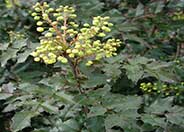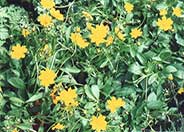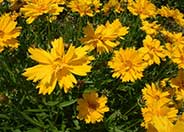
Common name:Oregon Grape
Botanical name:Mahonia aquifolium
Exhibiting erect growth, this evergreen shrub grows to a height of 6'. The leaves are 4"-10" long, with 5-9 very spiny-toothed, oval leaflets that are 1.5" in length.

Common name:Dwarf Eared Coreopsis
Botanical name:Coreopsis auriculata 'Nana'
A low, mat-forming perennial to 2' wide, the 'Nana' bears deep orange yellow flowers on short stalks from spring through fall (if deadheaded faithfully), and occasionally into winter. It requires sun and average watering. -Monterey Bay Nursery

Common name:Double Sunburst Coreopsis
Botanical name:Coreopsis grandiflora 'Double Sunburst'
The 'Double Sunburst' is a wonderful cultivar and a showy, Southern U.S. native. Golden yellow, double flowers on 2' bushy plants bloom from June to September in full sun and average to dry soils. It makes for good cut flowers, and pruning keeps the plants abundant with blooms. -Holland WIldflower Farm

Common name:California Fuchsia, Zauschneria
Botanical name:Epilobium canum canum
The California fuchsia is a perennial with dense, narrow, green gray foliage and red orange summer flowers. The growth habit of this plant is sprawling and low. The California fuchsia is native to California, is drought tolerant, and attracts hummingbirds. -Cornflower Farms

Common name:Lemon Bottlebrush
Botanical name:Callistemon citrinus
A large evergreen shrub, the Lemon Bottlebrush bears masses of bright red flowers in the spring and summer that are shaped, as the name implies, like a 'bottle brush.' New foliage grows in a bright, bronzy red.
Dealing With Drought
More than half of the water used at your home is for outside purposes. Studies show that on average, half of the water used outdoors is wasted. The leading cause of waste is incorrectly set and poorly managed irrigation controllers. The second biggest cause of wastage is broken irrigation equipment that goes undetected. There are a few basic things you can do to make a big difference in your water use.
Click in the green box for more information
| Designer: | Getting the Most Color Out of the Drive |
Photographer: GardenSoft |
Soils and Compost:
Practice grass-cycling by leaving short grass clippings on lawns after mowing, so that nutrients and organic matter are returned to the soil.
Water Saving Tip:
Be sure to fix all leaks promptly no matter how small they may seem.
Integrated Pest Management:
Attract, or buy beneficial insects such as ladybugs and lacewings to control pest outbreaks in your garden.

